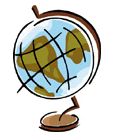Learn about the geography of Canada.
Objectives:
 Students will be able to name the regions of Canada.
Students will be able to name the regions of Canada.- Students will be able to identify the location of each region in Canada.
- Students will be able to describe the unique features of each region in Canada.
Suggested Grades:
4th Grade – 5th Grade – 6th Grade
Procedure:
- Read lesson or have students read it silently.
- Have students answer the questions on the worksheet.
- Discuss answers to questions.
Lesson Excerpt:
Canada is the second largest country in the world, spanning 3,200 miles from coast to coast. The country consists of six regions. The largest of these regions, the Canadian Shield, is the oldest part of North America. Once covered with glaciers, it is now mostly dense forests. There are also flat swamps called muskegs throughout the Canadian Shield. Muskeg is a Chippewa Indian word for swampy ground. There are many logging, lumber and paper companies in the Canadian Shield. The lakes and rivers created by melting glaciers are now used to power machines that make electricity.
The smallest region in Canada is the Great Lakes-St. Lawrence Lowlands Region. It is located in the southeastern part of Canada and borders the United States. The St. Lawrence River flows between the two countries. Often called the “Mother of Canada,” the St. Lawrence River was used by the first Europeans who explored Canada. Canada’s major cities of Quebec, Montreal, Ottawa and Toronto are built along this river. Since it is the warmest part of Canada, the growing season in this region is long enough for crops such as corn, beans, squash and sunflowers to grow. There are also fruit orchards and dairy farms in the St. Lawrence Lowlands.